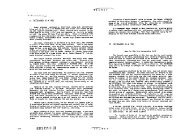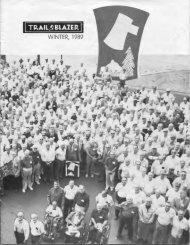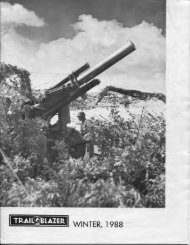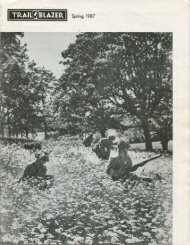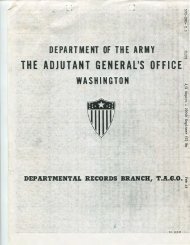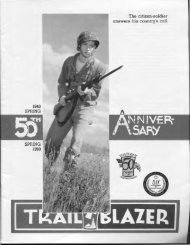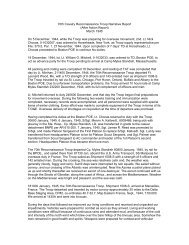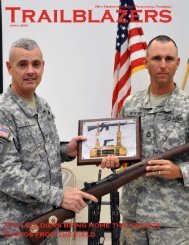Download - 70th Infantry Division Association
Download - 70th Infantry Division Association
Download - 70th Infantry Division Association
You also want an ePaper? Increase the reach of your titles
YUMPU automatically turns print PDFs into web optimized ePapers that Google loves.
of the enemy-held town of Oeting by E and F Companies; Second, taking of high ground southwest, west<br />
and northwest of Oeting by G and K Companies; Third, taking of the town of Oeting. Preparatory to the<br />
attack the Second Battalion, Maj. T. R. Mataxis commanding, established a forward CP at Folkling with<br />
right and left CP's from which to observe action in the first two phases.<br />
Supporting the attack were the 93rd Armored Battalion, a platoon of 4.2 mortars and elements of the<br />
2775th Engineers.<br />
The attack began, as scheduled, at 0001 6 February when E and F Companies moved out along the road<br />
running north from Gaubivingen, with E on the left, to accomplish the first phase. Enemy resistance was<br />
not heavy and the objective was taken at 0507.<br />
To accomplish the second phase, K and G Companies crossed the LD at 0630, K on the left. But now the<br />
enemy was alert and these two attacking companies met heavy small arms, automatic weapon and<br />
artillery fire. In spite of this stiff opposition, K and G attained their objective by 1100. Now the four companies<br />
held high ground overlooking Oeting in a general horseshoe from southeast of the town, to the<br />
south, to the southwest and up to the northwest.<br />
But the opposition which was overcome by K and G Companies proved to be only a forerunner of<br />
extremely stubborn enemy resistance that included heavy and accurate mortar and artillery fire, continued<br />
small arms and automatic weapon fire, and, on the following day, fire from tanks. For the rest of 6<br />
February the four companies held their positions on the limited objectives in the face of the mortar and<br />
artillery pounding by the enemy. Our supporting weapons reduced the effectiveness of the enemy's<br />
concentrations to some extent by counterbattery fire, but late in the afternoon this assistance still wa.s not<br />
sufficient to permit a continuation of the attack into the town of Oeting.<br />
By 1800 of 6 February we had taken 35 prisoners of war and had inflicted considerable casualties on the<br />
enemy with our small arms, automatic weapons, mortar and artillery fire, but we had also been suffering<br />
casualties through the day, chiefly from the enemy's artillery and mortars.<br />
As darkness approached, reports were received from F and G Companies that the large number of<br />
enemy in Oeting made an attack on the town inadvisable. At the same time, the enemy renewed and<br />
intensified his artillery fire on our positions. The Commanding Officer of the Second Battalion deemed it<br />
unwise to launch an attack to carry out the third phase of the engagement so late in the day, mainly<br />
because it was virtually certain to result in a night fight within the town.<br />
Thus, the coming of night 6 February found our forces still holding the high ground of phases 1 and 2.<br />
While this action had been taking place, O Company, assigned the mission of staging a raid into the town<br />
of Behren to kill or capture all possible enemy, carried out this order by sending one platoon into the town.<br />
Having carried out the mission, the platoon withdrew to its original position.<br />
During the night of 6 February the four attacking companies strengthened their positions and were<br />
prepared to lay down close in fires in case of counterattack. However, the night passed in comparative<br />
quiet.<br />
Shortly after daylight the enemy resumed his aggressive action against our positions with heavy fire from<br />
artillery. At the same time enemy infantry commenced counterattacks through infiltration tactics. This<br />
early morning action was beaten off, but later in the day there was additional infiltration supported by fire<br />
from enemy tanks and by continued artillery and mortar fire. Our counterbattery fire reduced to some<br />
extent the effectiveness of the enemy mortars and artillery, but never sufficiently to permit a renewal of<br />
the attack. The infiltration counterattacks were successfully staved off in all instances, although the<br />
second and third platoons of Company G had to withdraw to the CPL after receiving an attack from the<br />
front, both flanks and the rear, and after vainly attempting to contact Company K.



